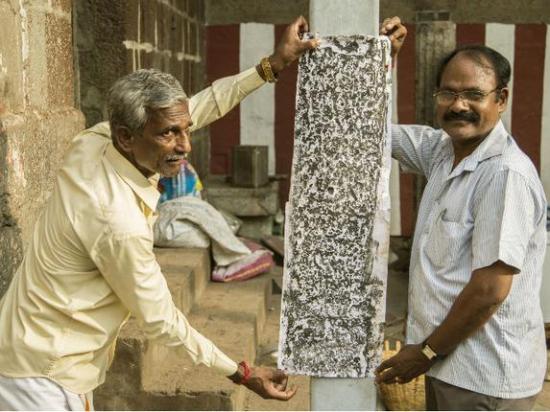T.S. Subramanian
Source - http://www.thehindu.com/news/cities/chennai/chennai-temple-yields-more-history/article7291998.ece
The famous Sri Parthasarathy Swamy temple at Triplicane here never ceases to amaze history buffs, it seems. The latest to pique their interest is the discovery of an inscription of the Chola emperor Rajendra I on the northwest corner of the sanctum sanctorum.
 The estampage of a Chola inscription newly discovered at the Sri Parthasarathy Swamy temple at Triplicane in Chennai. Photo: Tamil Nadu Archaeology Department
The estampage of a Chola inscription newly discovered at the Sri Parthasarathy Swamy temple at Triplicane in Chennai. Photo: Tamil Nadu Archaeology Department
Adding to the excitement is a mural depicting the Kurukshetra war, a row of horse-drawn chariots and fiercely moustachioed charioteers, all battle-ready, which has come to light as the cement plaster covering it fell off. The mural runs to many metres, but had been inexplicably covered with plaster.
 A mural depicting the Kurukshetra war uncovered at the temple. Photo: K.V. Srinivasan
A mural depicting the Kurukshetra war uncovered at the temple. Photo: K.V. Srinivasan
The temple is replete with inscriptions of the Pallavas, who are believed to have built it around AD 600, the Cholas, the Pandyas and the Vijayanagara kings. The latest find came to light last Friday while conservation work was taken up ahead of the Maha Samprokshanam at the temple on June 12.
K.V. Srinivasan, a photojournalist with The Hindu, who is associated with the temple, located the inscription and reported it to K.T. Narasimhan, consultant archaeologist/conservationist of the Tamil Nadu government. R. Kannan, Additional Chief Secretary, Tourism, Culture and Religious Endowments Department, who is leading the restoration and conservation work, instructed the Archaeology Department to take its estampage.
Eulogy
The fragmentary inscription offers a “prasasthi”, or eulogy, of Rajendra I, speaking of the fame of the emperor, who ruled between AD 1012 and 1044, and his conquests of many lands including in Vanavasi (Banavasi) and the present-day Kalaburgi region, both in Karnataka, and so on.
S. Vasanthi, Deputy Superintending Archaeologist, and R. Sivanandam, Assistant Superintending Epigraphist, who took the estampage and identified the inscription, said it had not been published so far.
Mr. Kannan has asked the temple officials to remove the plaster covering the mural to expose its entire length.
The robust physical features of the horses in the work, seen wherever the pigments are exposed, show the painting belongs to the late Pallava period, Mr. Narasimhan says.